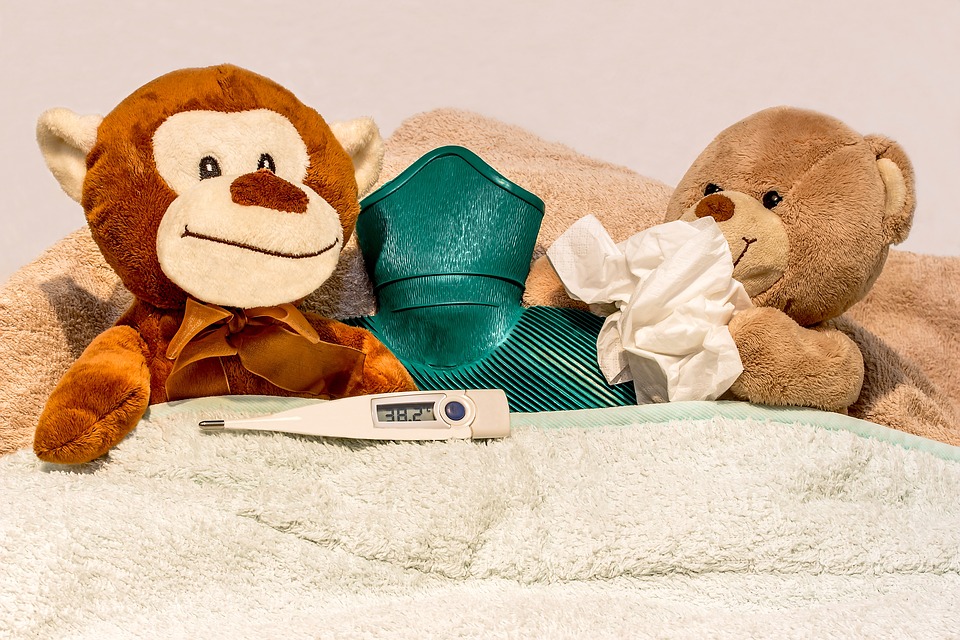The first and foremost concern of most parents is to keep their children in good health and in tip-top shape so that certain bacteria and viruses do not make them sick. These germs can damage the cells of the body, which may result to illnesses and infections like colds, coughs and extreme cases such as high fever, vomiting, or diarrhea.
Symptoms of Common Illnesses:
Common cold
Generally, kids get sick with colds during winters or cold weather. Symptoms of this illness are having a runny nose and severe nasal congestion which brings a lot of discomfort to children.
Cough
A cough may include wheezing, shortness of breath, sore throat and a runny nose.
Influenza
Also known as flu, this brings fever, cough, chills and muscle pain.
Measles
The common symptoms of measles are cough, runny nose, fever, spots in the mouth and rashes all over the body.
Mumps
A viral infection that involves swollen salivary glands, that causes fever, headache and low of appetite.
Diarrhea
Caused by certain viruses, the symptoms may include vomiting, cramps, tummy ache and watery stools.
Chickenpox
If a child has chickenpox, symptoms include a fever, itchy rashes or blisters, and a loss of appetite may be evident.
Dengue
Dengue is caused by a bite from an Aedes mosquito which carries the dengue virus. High fever, rashes, muscle and joint pain, and vomiting are just some of the symptoms of Dengue.
Gastroenteritis
Brought about by an intake of contaminated food and water, a child may suffer from a loose bowel movement, fever, abdominal pains and vomiting from Gastroenteritis. Cholera and typhoid fever are also caused by contaminated water.
Allergies
Allergies are caused by several types of allergens or allergy triggers. Your child may sneeze, cough or may develop hives or skin rashes from a food allergy.
Most communicable illnesses such as flu, cough and colds, measles, mumps and the chicken pox, among others, are infections that are easily transferred to others. Communicable diseases are airborne which means that they are transmitted and spread through air. An infected person spreads the germs into the air by coughing or exhaling, and the bacteria enters into another person’s body by breathing it in crowded places such as trains, buses and movie houses with very poor ventilation. It’s important to consider a childcare centre or kindergarten in your local area that provides great ventilation and hygiene to ensure your children stay healthy in a crowded environment! A great Kindergarten at Carlton provides a well-ventilated area and a space that’s favorable to learning and your children’s health.
Illnesses can also be spread by touch and when one is in physical contact with the infected person or through indirect means. For instance, when one uses the personal belongings of the infected person; like using the same towel and sharing of food and utensils when eating.
The following preventive measures are suggested to avoid illnesses among toddlers and preschoolers:
- Keep the kids clean by giving them their daily baths and clean clothing. Keep the house and surroundings dirt-free and tidy, especially the area where they spend most of their time. Cleanse and disinfect objects and surfaces regularly, particularly the toys handled by the kids and by that of their playmates. Keeping the play areas well-ventilated preferably with enough fresh air and sunlight coming in is also helpful. Our early learning centre at Carlton ensures all these standards are met to help your children grow healthy and strong!
- Boost your child’s immunity by encouraging them to get enough rest and sleep, eat healthy foods, drink 8 glasses of water each day, and engage in outdoor activities to improve their physical health. Also, provide their daily dose of vitamins.
- Be quick to note the infected or sick persons who visit your home and find ways to keep the kids from having physical contact with them. The same has to be done even with their schoolmates. A childcare centre at Carlton such as The Little Cottage is always prepared to assist parents in addressing any issues and informing them of the symptoms that their kids or the other kids show.
- Vaccinate your child to keep him or her protected from life-threatening diseases. Talk to your doctor or speak with a healthcare professional about your child’s immunisation schedule as vaccinations are given at certain times.
- Teach your kids to cover their mouth when coughing and sneezing, and teach them proper hygiene by washing their hands after touching and caressing pets, after using the comfort room, and after playing with friends. Good personal hygiene habits are also taught and strongly encouraged at our preschool in Carlton. Washing hands with soap and water is the easiest way to stop the spreading of germs. If washing with soap and water is not possible in some places, one can use the hand sanitizer to remove the germs from their hands
Educating your children the importance of cleanliness and proper hygiene can inculcate healthy and safety habits, which may provide a higher quality of life for them. By demonstrating a healthy lifestyle, regularly reminding them of the Do’s and Don’ts, and by being observant of your child’s behavior, you can be confident knowing that you are creating a safe, caring and healthy environment for your little ones.
Enjoyed having a read of our blog post? Learn about the benefits of playing outside by our childcare centre in Miranda.
*Disclaimer: The information on this blog is not intended to be a substitute for professional diagnosis, treatment or medical advise. The content of this blog is for general information purposes only. Always ask the advise of your child’s paediatrician, a physician, or a qualified healthcare provider for the best medical advise for your child’s condition.Photos Courtesy of: Myriams-Fotos / 1321 images via Pixabay under the Creative Commons CC0 licence. (Featured Image) Semevent / 56 images via Pixabay under the Creative Commons CC0 licence. dhanelle / 7 images via Pixabay under the Creative Commons CC0 licence.
